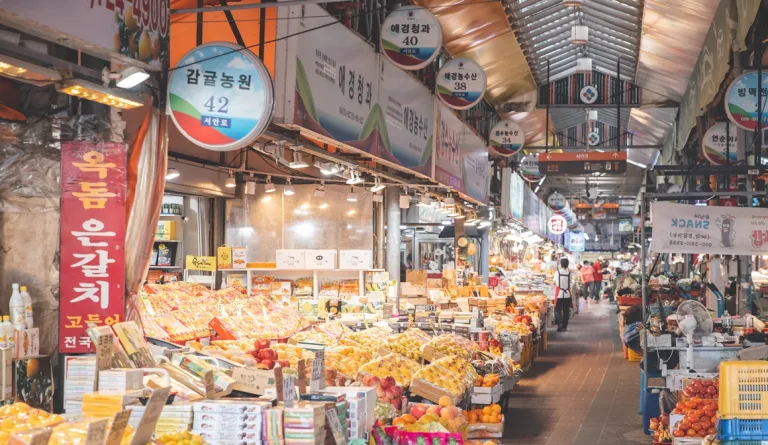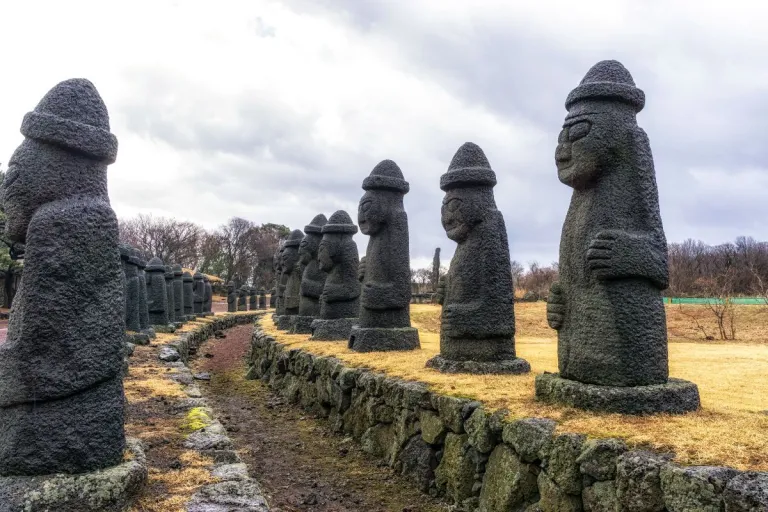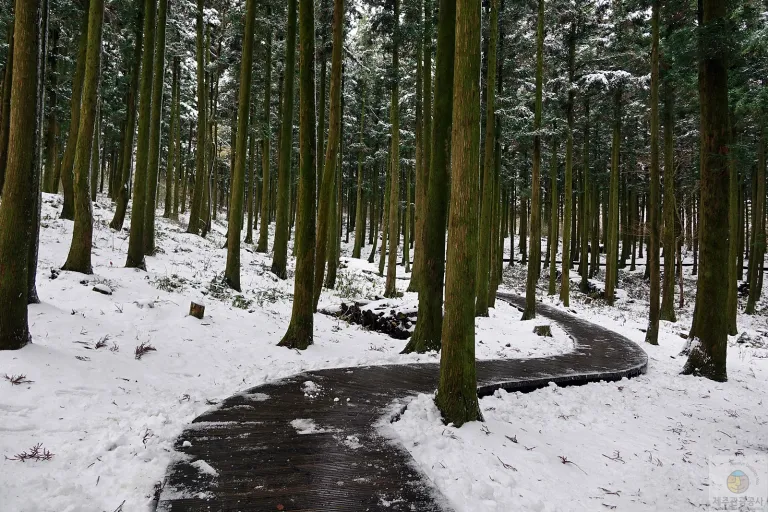想要趁着周末或公共假期在国内旅游, 但只能想到槟城极乐寺、 吉隆坡双峰塔、 热浪岛, 又觉得这些地方太主流、 人又多、 而且没新鲜感了吗? 今天,小编就要来向大家介绍一些马来西亚可媲美国外、 鲜为人知的冷门景点吧·!
5D4N in Jeju: The Ultimate Jeju Winter Itinerary

When it comes to famous destinations in South Korea, Jeju Island ranks as one of the top choices for a holiday. And yet, for most travellers, their dream Jeju vacation often consists of sunny days on the beach and hiking alongside lush greenery. However, did you know that there are plenty of things to do in Jeju in winter too?
Forget what you already know about the “Hawaii of South Korea” and join us on an epic trip to discover the many winter gems that Jeju has to offer!
When is the winter season in Jeju?
 Image credit: ninglu via Canva Pro
Image credit: ninglu via Canva Pro
Winter in Jeju typically runs from late November to early February. During this time, the island boasts cooler weather and fewer crowds, making it the perfect time for a relaxing trip to South Korea’s most famous island.
Is there snow on Jeju Island?
Unlike the harsh winters of Gangwon or Seoul, Jeju’s winter climate is milder with gentle winter breezes. That said, certain areas of Jeju (usually places at higher altitudes) often see snow, particularly around the Hallasan Mountains.
TripZilla tip: While Jeju Island does have a public bus system, we recommend availing to a private car hire for the best winter travel experience in Jeju.
Day 1: Admiring winter scenery at Jeju Ecoland → Food hunting at traditional markets
 Image credit: Ecoland Jeju Facebook Page
Image credit: Ecoland Jeju Facebook Page
Located in the middle of the Gotjawal Forest, Jeju Ecoland is an expansive theme park (around one million square metres) that is famous for its train ride — electric-powered trains modelled after classic steam locomotives from the 1800s, running along the only train track on the island.
When you visit Ecoland in spring or summer, the train ride takes you through lush rainforests and whimsical scenery, with each station offering different views and experiences. However, during winter, the ride becomes even more memorable as the forest is blanketed in fluffy layers of snow. As you pass through the snow-covered woods, it will feel as if you’ve been transported into a fairytale story!
 Image credit: Visit Jeju
Image credit: Visit Jeju
Apart from the unforgettable train ride, there are also other experiences. My favourite is the Gotjawal Healing program, an immersive experience that rejuvenates your mind and body amidst the embrace of nature.
Checking out the vibrant traditional markets
 Image credit: Visit Jeju
Image credit: Visit Jeju
There are several traditional markets to check out in Jeju, each selling a variety of souvenirs, snacks, and street food. Arguably, the two most famous markets in Jeju are the Dongmun Traditional Market in Jeju-si, and the Seogwipo Maeil Olle Market.
The Dongmun Traditional Market is a vibrant and bustling marketplace that offers a glimpse into the island's rich culture and local life. It is the island's biggest and oldest permanent market, and you can expect to find plenty of things to buy and eat here, ranging from unique local handicrafts to fresh seafood and produce and even unique snacks.
At the back of the fresh market, you’ll find a food market which sells incredible street food — imagine digging into a hot serving of eomuk (Korean fishcake) in the winter, such bliss!
 Image credit: Visit Jeju
Image credit: Visit Jeju
Meanwhile, Seogwipo Maeil Olle Market is the largest indoor market in the Seogwipo-Si area. Stretching over 600m, it offers a variety of fresh and cooked seafood, as well as local souvenirs, and snacks. You will often also find outdoor cultural performances when you visit!
Day 2: Snow trekking on Hallasan Mountain → Foodie tour through Jeju’s popular food spots
 Image credit: july7th via Canva Pro
Image credit: july7th via Canva Pro
One of the most alluring locations to visit in Jeju during winter is Hallasan Mountain. This majestic shield volcano, an iconic landmark of the island, is famous for its stunning views and hiking trails that showcase Jeju’s natural beauty. The winter season transforms the verdant scenery into slopes draped in fluffy snow, offering a whole different experience.
While all five of Hallasan Mountain’s main hiking trails (namely Yeongsil, Eorimok, Seongpanak (usually the most popular), Gwaneumsa, and Donnaeko) remain open for winter trekking, we recommend embarking on the Yeongsil Trail for the best “snowflower” trek experience.
 Image credit: Visit Jeju
Image credit: Visit Jeju
That’s because this trail, famous for its enigmatic cliffs and stunning mountain ridges, offers the best winter scenery in Jeju. The eye-catching Byeongpung Rocks that line the path offer sights that you won’t soon forget. The entire hike would take around three hours one way, with both ridges and flat paths along the way. The toughest part of the trail is the uphill climb starting from the Yeongsil Rest Area, which takes you to the Nambyeok Watershed Observatory.
Alternatively, if you’re up for a challenge, you could make your way to the Baengnokdam Crater Lake along the aforementioned Gwaneumsa Trail. It is arguably one of the more challenging hiking trails in Jeju, but one that offers stunning views once you reach the peak.
TripZilla tip: If you’re not in the mood for climbing, you can simply hop in a car and head to 1100 Highland, a rest area along the 1100 Road (the highest altitude road in Jeju). Here, you can admire majestic views of the snow-covered peaks of Hallasan from the comfort of your car, or hit up the natural sled park for some winter fun with the family.
Sampling Jeju’s mouthwatering cuisine
 Image credit: ROMIXIMAGE via Canva Pro
Image credit: ROMIXIMAGE via Canva Pro
After a tiring hike up Hallasan, the best way to recharge your body is to indulge in a delicious meal and taste the best things to eat in Jeju. As some of you who are fans of Korean dramas and Korean variety shows (any Running Man fans here with me?) may know, Jeju is famous for its heukdwaeji — black pork, often the star of a barbecue meal on the island.
The best place to visit for black pork BBQ is undoubtedly Jej’s famous Black Pork Street on the island’s historic downtown area. Here, you’ll find rows of shops selling the famous delicacy. If you miss the giant sign at the entrance, you will surely know you’re in the right place by the smokey smell that will make your tummy rumble.
 Image credit: Lcc54613 via Canva Pro
Image credit: Lcc54613 via Canva Pro
Some of the popular foods to eat in Jeju during winter include momguk, a traditional folk soup dish in Jeju that includes gulfweed and pork; classic pork noodle soup (gogi guksu); and — my personal favourite, seafood porridge topped with abalone (a must-try in Jeju).
If you’re looking for an after-dinner nightcap, there are plenty of artisanal bars in the area where you can sample different beers, soju, and whiskey before calling it a day.
Day 3: Picking tangerines → Admiring stunning fields of camellia flowers
 Image credit: Visit Jeju
Image credit: Visit Jeju
On day three of your visit to Jeju, head to the expansive Seogwipo-si area. Here, you can dive into some of the more relaxing winter activities in Jeju, like picking tangerines (Red Hyang and Hallabong) and strolling along fields of camellia flowers.
Hallabong, a citrus fruit known for its unique shape, is Jeju’s representative fruit, while Red Hyang tangerines are a cross between Jeju's iconic Hallabong and Noji Tangerines and are known to be extremely sweet.
Both Hallabong and Red Hyang often begin to fruit and ripen in October, making the winter season (mid-November especially) the best time for mandarin picking. Indeed, it’s during this time when most of the fruit orchards open and begin offering this fun activity in Jeju. As you might expect, a typical fruit-picking experience involves learning how to identify which ones are ripe for picking, how to harvest the mandarins off the branch, and, of course, sampling the sweet, juicy Hallabong and Red Hyang you’ve picked.
 Image credit: Visit Jeju
Image credit: Visit Jeju
Some of the mandarin orchards also offer hands-on activities where you can turn the mandarins you’ve picked into jams, candy, or even candles! Some of the popular farms for picking tangerines in Jeju are Jeong Seok-won Farm, Haepoomeun Farm, and Jeju Jerahyang Farm, all of which are located in the Seogwipo-si area.
Decorate your social media feed with blooming camellias
 Image credit: J.Park via Canva Pro
Image credit: J.Park via Canva Pro
Often when we imagine winter, we picture snow-laden fields and leaveless trees. However, in Jeju, the camellia flowers often bloom during the winter season between November and March, adding a spot of colour to the island’s whimsical scenery.
Known for their vibrant shades of pink, red, and white, camellia flowers are one of the most popular natural attractions in Jeju. Camellia Hill is arguably the most famous location to see these colourful blooms. However, we recommend heading to the lesser-known Camellia Village in Shinheung 2-ri instead for equally impressive views minus the usual tourist crowds.
At this historical village (with over 300 years of history), you’ll find paths laden with striking red camellias during the winter season. As you enjoy a leisurely stroll along the camellia-lined paths, combined with the ambient surroundings of the village, you’ll be able to learn more about the significance of the flowers as well as the history and heritage of the island. There’s even a haenyeo (Jeju’s famous women divers) experience school here.
 Image credit: bong hyunjung via Canva Pro
Image credit: bong hyunjung via Canva Pro
Apart from filling your Instagram feed with bursts of camellia colours, there are also hands-on programs in the village where you can turn camellia into fragrant soap and sample a plethora of delicious, homey meals.
If you have time to spare, you can take a detour to Seongeup Folk Village in Pyoseon-myeon where you can try your sign-up for a traditional pottery workshop and craft Korean earthenware (known as Jeju onggi) like bowls and cups.
TripZilla tip: Depending on your mode of transport, the travel time between Seogwipo-si and Jeju-si (where most travellers find accommodation) could take up to an hour or more. So, we recommend going for a meal here before embarking on your journey back.
Day 4: Visiting Seongsan Ilchulbong → Ferry ride to Udo Island
 Image credit: Claudia Prommegger via Canva Pro
Image credit: Claudia Prommegger via Canva Pro
No trip to Jeju is complete without a visit to Seongsan Ilchulbong (Sunrise Peak), one of the most iconic natural gems on the island and a UNESCO World Heritage Site. As the name suggests, Seongsan Ilchulbong is known for its spectacular sunrise scenery and is especially popular on New Year’s Day.
For those not in the know, the Seongsan Sunrise Festival is an annual event that lasts from 30 Dec until 1 Jan of the following year. Festival goers can ring in the new year with a music festival and a countdown laser show before hiking up the peak on New Year’s Day to welcome the first sunrise of the year.
Even if you’re not visiting Seongsan Ilchulbong during the new year period, it is still a worthwhile location to visit during winter in Jeju. As you hike to the peak (it takes about an hour) in the chilly winter air, expect some lovely views, especially once you reach the crater at the top. On your way down, you can also spot haenyeo going about their daily activities.
Hopping on a ferry to Udo Island
 Image credit: Kheng Kheng Tang via Canva Pro
Image credit: Kheng Kheng Tang via Canva Pro
After checking out Jeju’s famous sunrise peak, you can head to the jetty nearby and board a ferry to Udo Island, a small land mass shaped like a cow. The island is home to volcanic rocks, verdant farms, beaches, and a postcard-worthy lighthouse perched atop a hill.
One of the best things to do on Udo Island is to rent a bike and check out the many scenic spots along the shore. In particular, you don’t want to miss Jiducheongsa, which offers panoramic views of the island from Udo Peak. Another location that makes for a great #potd spot is the Udo Lighthouse located on the southern tip of the island.
Once you’re done with your Udo sightseeing tour, stop by Sanho Beach where you can try some of the island’s famous peanut ice cream and watch the waves beat against the shore. Alternatively, you can also head to one of the cafes and enjoy a nice coffee in the chilly winter air.
Day 5: Checking out O’Sulloc Tea Museum
 Image credit: 시선 via Canva Pro
Image credit: 시선 via Canva Pro
On your final day in Jeju, you will have just about enough time to visit the O’Sulloc Tea Museum before heading for your flight at the airport. As the name suggests, the O’Sulloc Tea Museum, one of the famous attractions in Jeju, is all about the island’s tea plantations and heritage.
Here, you can discover how the freshest tea leaves are harvested and turned into tea and other types of food. The main activity here is actually shopping as this is where you can get your hands on a multitude of high-quality tea and tea-flavoured snacks and products. After filling your shopping cart, it’s time to bid farewell (for now) to the lovely winter wonderland that is Jeju, until your next trip to the beautiful island!
Other winter attractions in Jeju
Apart from the locations mentioned in this 5D4N itinerary, there are also a ton of other things to do in Jeju during winter. If you’re on an extended holiday on the island (frankly, we’re envious!), then consider fitting these experiences into your travel plans.
Jeju Stone Park
 Image credit: aaron90311 via Canva Pro
Image credit: aaron90311 via Canva Pro
In case you didn’t know, Jeju Island is a volcanic island with 360 cones. Its creation comes with a fascinating involving a mythological grandmother named Seolmundae Halmang, who is regarded as the one who created the island.
Jeju Stone Park, a park dedicated to preserving Jeju's stone culture, keeps this legend alive, offering educational programs and a yearly festival to honour Seolmundae Halmang's significance in Jeju's history and culture. Beyond that, the location is certainly an Insta-worthy place to visit. Surrounded by volcanic cones and a lush forest, the park is especially stunning in winter when snow covers the black volcanic stones.
Roe Deer Observation Center
 Image credit: Visit Jeju
Image credit: Visit Jeju
The Roe Deer Observation Center is a 500,000-square-meter park where you can see around 200 deer roaming freely. Naturally, it's a fantastic place for kids and nature enthusiasts where visitors can learn about local wildlife and even feed the deer (feeding times are at 9am and 3:30pm). More importantly, the park has a long walking trail that becomes even more enchanting during winter as it is one of the few locations in Jeju that sees snow.
Jeolmul Natural Recreation Forest
 Image credit: Visit Jeju
Image credit: Visit Jeju
Speaking of snow in Jeju, another must-visit location during winter is Jeolmul Natural Recreation Forest, known for its cedar tree forest. Coupled with fresh snow on the ground, a stroll here is akin to stepping into a fairytale or, if I do say so myself, a melancholic Korean romance drama! If you’re not a fan of self-exploration, you can also sign up for one of the many forest experience programs here that includes a guided tour of the area.
And there you have it: The perfect 5D4N itinerary to explore Jeju during the winter season! If you’ve never been to the island during winter, we highly recommend making travel plans to do so. It’s a whole different experience compared to visiting during the summer months or even autumn. Who knows? You might just fall in love with Jeju even more after the trip!
For more information about travelling to Jeju during winter, check out the official website of the Jeju Tourism Organization.
Brought to you by Jeju Tourism Organization
Published on
About Author
RECOMMENDED READS
本地旅游好好玩! 马来西亚 10个 2025 必游的仙境 【Pulau Langkawi爆红住宿TOP 8】超高颜值的酒店,照片请来一波! 9月16日。。。约吗?
【亚洲跨年烟花TOP 8】带上家人和另一半欣赏爆炸式的浪漫! 每年的跨年大集会, 除了有歌舞升平的好气象之外, 还会有各种烟花大会, 迎接2020的到来~ 为你推荐这些超吸睛的烟火会, 还不赶快带上你最亲爱的去欣赏这份免费的浪漫情怀?!
【冬季篇】日本必去打卡的秘境TOP 10✅ 日本, 是亚洲一个神奇的旅游胜地。 但凡去过一次, 就会上瘾, 然后就会想要探索那里的春夏秋冬。 日本的冬季, 可以达到零下的温度, 甚至有很多越冷越受欢迎的景点。值得一提的是, 日本的冬季集浪漫、 萧条、 迷人为一身。 你也可以趁着冬季来到北海道滑雪, 或是泡一个美美的温泉! 无以伦比的旅行就此开始。
【学生党付得起的价位】新加坡超美味的豪华美食清单TOP 8! 以前总听别人说新加坡的食物不好吃, 那是因为不会吃吧! ~当然, 要享受到顶级的服务和美食, 钱包就一定不能太省啦! 毕竟马币兑新币汇率真的太高了。 不过, 为了吃真的不能省。 如果接下来想逗女朋友开心, 或是想慰劳一下家人, 就去邻国趴趴走吧!
RECENT ARTICLES
打工度假指南 海外生活加赚钱?看看马来西亚人的 Working Holiday 可行选项。
Semporna: A Complete Guide to Southeast Asia’s Premier Island Paradise Explore Semporna’s islands, diving, culture, and cuisine
Top PADI Certification Locations Across Malaysia Discover the best places to get PADI certified across Malaysia
Da Nang and Hoi An: Why Central Vietnam Is the Best Destination for Malaysians Da Nang and Hoi An: Vietnam’s Top Destination for Malaysians
Hiking in Klang Valley: 8 Beginner-Friendly Hills with Great Views A guide to eight beginner-friendly hills in the Klang Valley.

